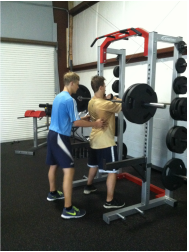
-Steven Covey,
The Seven Habits of Highly Effective People
I see this quote everyday when I turn on my computer. I keep a few very meaningful quotes on my desktop that I find most important to me in my daily life as a coach, husband and father. This one really pertains to all aspects of my life, but is particularly important when discussing the in-season training of athletes.
How do you design an effective in-season strength & conditioning program? The first thing you must start with is the MAIN THING. So obviously the main thing for an in-season athlete is WINNING… it is 2013. So my goal as the strength & conditioning coach is to do whatever is necessary to improve the likelihood of improving an athlete’s chances of winning. This creates a very fluid environment between the athlete and the S&C coach because what can lead to an improvement in an athlete one week may deter from improvement the next week. The key component is open and honest communication between all parties involved (sport coaches, athlete, parents, S&C coaches, etc.). Examples being if its preseason and you have had 3 hour practices for the last 10 days, I would probably not be interested in your hang clean personal record (PR). But that does not mean that training sessions should not have a purpose during that time. Recovery and regenerative methods can be utilized to improve the recovery time and effectiveness. Conversely, if you are in the midst of a competitive season, sessions can be designed to improve qualities such as power or strength. I have had many cases in my career where athletes that I work with did set a PR during the season. As a competitive athlete at West Virginia University I took great pride in that during my final season I had my best back squat numbers the last week of our regular season.
| And that really is the goal of in-season strength & conditioning, not to set PRs in season, but to be in the same ballpark with all the qualities we look to improve as S&C professionals at the end of the season (where the games that matter most are scheduled) compared to the beginning, and also to reduce the likelihood of injury. The injury prevention work is an entirely different issue. Statistically, the majority of sports related injuries occur in the second half of the season; as the demands of sport mount over a season sometimes it can be too much and an injury can occur. A simple analogy is if you are a racecar driver you can just operate, pedal to the floor, for the entire 500 miles. You need to come in and take a pit stop. And that is all good in-season strength & conditioning program is; we look to be quick and efficient (45-60 mins, sometimes less), we make small adjustments to improve performance, when appropriate, and do all that we can to help athletes recover and avoid injury to the greatest extent possible. |



 RSS Feed
RSS Feed